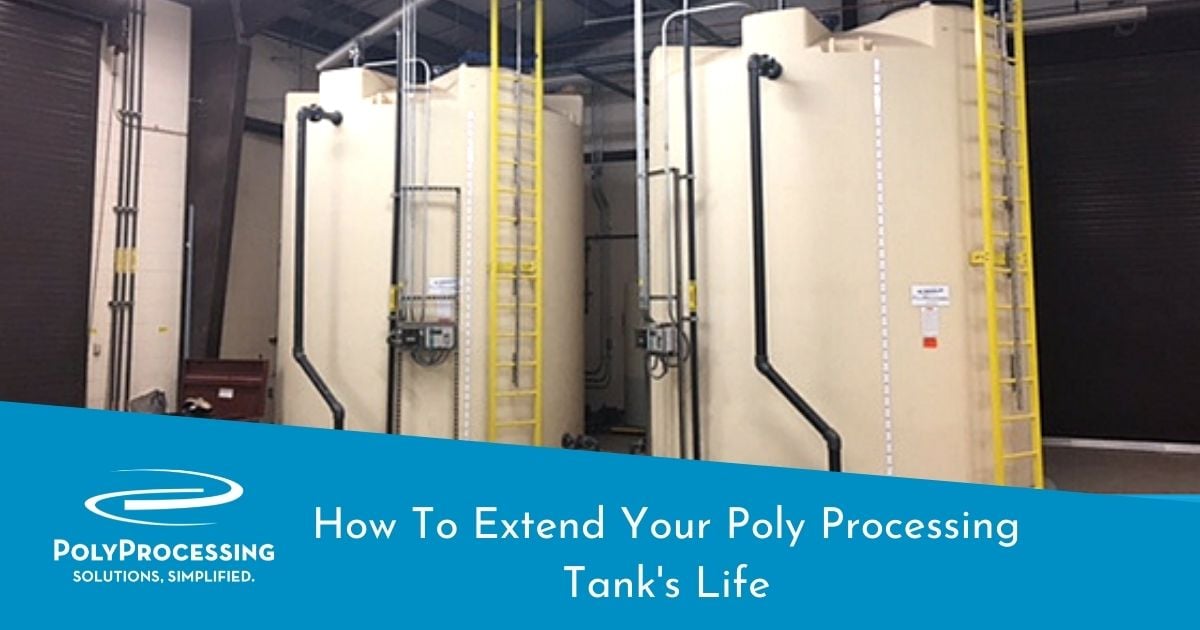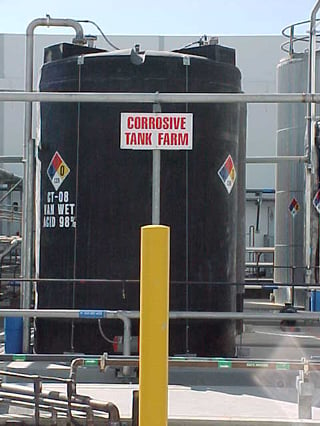How To Extend Your Poly Processing Tank's Life
When companies are purchasing a chemical storage tank, they often ask, “How long will the tank last?” We wish we could answer that question, but it’s a lot like asking, how long are you going to live? Just as a top athlete can die young from an injury and a lifelong smoker can live into their 90’s, there’s no way to predict exactly how long a specific chemical tank will last.

Our cross-linked polyethylene tanks come with a five-year warranty, but our customers report an average life of 15-20 years, or more. However, there are many variables that affect a tank’s life making it impossible to determine how long any particular polyethylene tank will last.
But you can often extend the life of your chemical storage tank by controlling six critical variables. Let’s take a look at each one of them.
Chemical, Concentration and Temperature

The chemical, weight of the chemical, concentration and operating temperature are all factors that influence the life expectancy of a polyethylene tank. For example, high concentrations of Sulfuric Acid are considered stress-causing agents and are more aggressive oxidizers than less concentrated chemicals such as 25% caustic soda. If you need to store aggressive chemicals, you can extend the useful life of your tank by choosing the OR-1000™ antioxidant system.
Another example is concentrated sodium hypochlorite (12%), which degrades from UV exposure and elevated temperatures. As it degrades, sediment builds in the bottom of the tank, which can cause more oxidation in the bottom section of the tank. This can lead to a shorter tank life. The Integrally Molded Flanged Outlet® (IMFO®) tank can eliminate this sludge buildup by promoting continuous system flushing.
Temperature can play a role if some chemicals, such as sodium hypochlorite, are delivered hot. In this case, sediment can drop to the bottom of the tank. When a new batch is introduced to the tank, it can cause a reaction with the sediment, releasing free radicals into the tank and creating premature failure in the dome and sidewall of the tank.
Installing the Correct Piping

One of the single biggest reasons for a reduced tank life is improper tank installation and “hard” piping. Polyethylene’s chemical resistance is partially based on its ability to expand and contract. Flexible connections compensate for tank expansion and contraction, promoting a longer useful life.
If proper flexible connections aren’t installed, any kind of movement of the tank can put harmful stress on the plumbing and cause a break or breach to peripheral plumbing. Rigid plumbing could crack the tank, potentially creating a hazardous situation.
To ensure your installation doesn’t fail prematurely, it is critical to follow Poly Processing Company’s Installation Manual Instructions.
Venting
Venting is an often overlooked but a critical step that promotes tank longevity. Adequate vent size is always based on flow and delivery rates, so it is important to gather the following information to adequately determine the proper venting requirements:
- Will the tank be filled pneumatically?
- Will the tank be vented to atmosphere?
- Does the length of the vent exceed three feet (piped to a central vent system)?
- Will a fume scrubbing system be used?
- Will vent screens be used?
- Does the tank manufacturer offer a method of “emergency venting” to prevent over pressurization?
Poly Processing Company takes this information and your specific storage requirements and creates a venting system that meets or exceeds your standards. See our Venting Design for ACFM Technical Paper and our venting page for more information on venting systems for your specific application.
Manufacturer’s Warranty
The challenge behind any warranty is how well the manufacturer supports the warranty when something happens during the warranty period. Poly Processing Company is the industry leader in the useful life of a tank. Some manufacturers including poly tank manufacturers design their tanks to last just beyond the warranty period, but Poly Processing intentionally designs our tanks for the maximum life possible. That’s why many of our tanks exceed the warranty period three to four times over.
Poly Processing Company prides itself with a top-of-the-line field service team with over 50 years’ combined experience. Should an issue arise under warranty or after the warranty has passed, we’re fully equipped to service your tank needs.
The Right Tank for a Long Life
There’s no way to predict how long any chemical tank will last. But if you design it right, build it right, and install it right, you’ve got the best chances for a tank that outlasts your expectations.
Make sure you get the right tank for the longest life possible—talk to one of our chemical storage tank experts today.
- May 17, 2021
About Poly Processing
Posts By Topic
Tech Talk Podcast Episodes
Subscribe By Email
Recent Posts
- Installation Tips for Chemical Storage Tanks: Site Preparation and Offloading
- Understanding pH and Chemical Concentration When Choosing a Chemical Tank
- Maximizing Fill Efficiency: Selecting the Optimal Fill Line System
- Chemical Storage Tanks: A Quick Guide for End Users
- Popular Customization Options for Chemical Storage Tanks
Tank Configurator

Find the recommended tank and system components for your chemical storage challenge.
Configure a Tank Package




